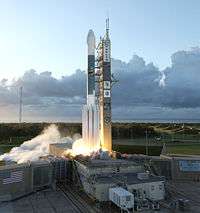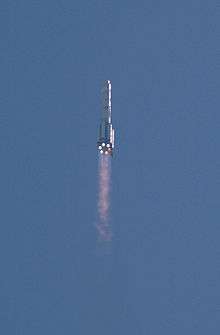Expendable launch system


An expendable launch vehicle (ELV) is a launch system or launch vehicle stage that is used only once to carry a payload into space. Historically, satellites and human spacecraft were launched mainly using expendable launchers.
Their components are not recovered. This contrasts with a reusable launch system or RLV, in which some or all of the components are recovered intact. The vehicle typically consists of several rocket stages, discarded one by one as the vehicle gains altitude and speed.
A few companies are developing reusable launch systems intended to cut costs. A reusable launch vehicle, such as the SpaceX Falcon 9 first-stage booster, may be flown in "expendable configuration" to increase performance, although this is unusual. The now-retired Space Shuttle was one of the earliest RLVs. The concept behind the Space Shuttle idea would be that by creating a reusable launch vehicle, it'd drive down costs of launching payloads because hardware that was flown previously was available to launch a second payload. Unfortunately. this concept backfired on NASA, and with the Challenger accident, this made NASA mandate heavy refurbishment of all Space Shuttle vehicles returning from STS missions. This, in a counteractive move, actually increased the launch price so high that it virtually became indifferent, even cheaper, to launch a payload on a Delta II or Ariane 4, both expendable launch vehicles. [1]
Expendable configuration of reusable launch vehicles
Some reusable launch vehicles are, on occasion, launched to orbit in "expendable configuration." For example, EchoStar 23 was launched to orbit in March 2017 on an RLV Falcon 9 where the first stage carried no grid fins nor landing legs,[2] and used all of the requisite propellant for landing to impart additional energy to the heavy mass of the large commsat payload being transported to geosynchronous orbit.[3]
Development
European sponsorship
On March 26, 1980, the European Space Agency and the Centre National d'Etudes Spatiales (CNES) created Arianespace, the world's first commercial space transportation company. Arianespace produces, operates and markets the Ariane launcher family. During 1995 Arianespace lofted its 100th satellite and on 23 September 1997 the Ariane rocket had its 100th launch.[4] Arianespace's 23 shareholders represent scientific, technical, financial and political entities from 10 different European countries. The major shareholder is the CNES, with 34.68% of capital.[5][6]
American deregulation
From the beginning of the Shuttle program until the Challenger disaster in 1986, it was the policy of the United States that NASA be the public-sector provider of U.S. launch capacity to the world market.[7] At the start, NASA subsidized satellite launches, intending to eventually price Shuttle service for the commercial market at long-run marginal cost.[8] On October 30, 1984, United States President Ronald Reagan signed into law the Commercial Space Launch Act.[9] This enabled an American industry of private operators of expendable launch systems.
On November 5, 1990, United States President George H. W. Bush signed into law the Launch Services Purchase Act [10] The Act, in a complete reversal of the earlier Space Shuttle monopoly, specified that NASA is to purchase launch services for its primary payloads from commercial providers whenever such services are required in the course of its activities.[11][12] This eventually lead to the NASA COTS program.
Russian privatization
The Russian government sold part of its stake in RSC Energia to private investors in 1994. Energia together with Khrunichev State Research and Production Space Center constituted most of the Russian manned space program. In 1997, the Russian government sold off enough of its share to lose the majority position.
American subsidization
In 1996 the United States government selected Lockheed Martin and Boeing to each develop Evolved Expendable Launch Vehicles (EELV) to compete for launch contracts and provide assured access to space. The government's acquisition strategy relied on the strong commercial viability of both vehicles to lower unit costs. This anticipated market demand did not materialize, but both the Delta IV and Atlas V EELVs remain in active service.
Russian renationalization
Beginning in 2013, the Russian government began a renationalization of the Russian space sector. Among the actions taken was the formation of the United Rocket and Space Corporation (Russian: Объединенная ракетно-космическая корпорация) to consolidate a large number of disparate companies and bureaus.[13][14] The efforts have continued into 2014.[15] On 19 May 2015 State Duma passed a bill on a creation of Roscosmos State Corporation, further consolidating the industry.[16]
Launch alliances
Since 1995 Khrunichev's Proton rocket is marketed through International Launch Services while the Soyuz rocket is marketed via Starsem. Energia builds the Soyuz rocket and owns part of the Sea Launch project which flies the Ukrainian Zenit rocket.
In 2003 Arianespace joined with Boeing Launch Services and Mitsubishi Heavy Industries to create the Launch Services Alliance. In 2005, continued weak commercial demand for EELV launches drove Lockheed Martin and Boeing to propose a joint venture called the United Launch Alliance to lower costs for the United States government.[17]
See also
References
- ↑ Wall, Mike (2011-07-05). "NASA's Shuttle Program Cost $209 Billion — Was it Worth It?". Space.com. Retrieved 30 July 2018.
- ↑ Clark, Stephen (2017-03-13). "Falcon 9 booster minus landing legs and grid fins poised for launch". SpaceFlightNow. Retrieved 2017-12-25.
- ↑ "TV broadcast satellite launched aboard Falcon 9 rocket". Spaceflight Now. 2017-03-16. Retrieved 2017-12-25.
- ↑ Arianespace: milestones Accessed 26 April 2017
- ↑ Arianespace: shareholders Archived 2014-10-08 at the Wayback Machine.
- ↑ company-profile (appears to give different shareholdings from those in main text); arianespace.com Accessed 26 April 2017
- ↑ Setting Space Transportation Policy for the 1990s, Congressional Budget Office, October 1, 1986 Accessed 26 April 2017
- ↑ Seedhouse, Erik (2012-02-22). Astronauts For Hire: The Emergence of a Commercial Astronaut Corps. Springer Science & Business Media. ISBN 9781461405207.
- ↑ Statement on signing the Commercial Space Launch Act, October 30, 1984, at reagan.utexas.edu/archives/speeches/1984 Accessed 26 April 2017
- ↑ Space Frontier Foundation — Advancing Newspace, championing ideas for opening the space frontier to human settlement as rapidly as possible
- ↑ 104 STAT. 3188 - LAUNCH SERVICES PURCHASE ACT OF 1990, 16 November 1990, US Government Publishing Office.
- ↑ Title II, Launch Services Purchase Act of 1990, Section 201
- ↑ Messier, Doug (2013-08-30). "Rogozin: Russia to Consolidate Space Sector into Open Joint Stock Company". Parabolic Arc. Retrieved 2014-09-11.
- ↑ Messier, Doug (2013-10-09). "Rogozin Outlines Plans for Consolidating Russia's Space Industry". Parabolic Arc. Retrieved 2014-09-11.
- ↑ Messier, Doug (2014-01-05). "Big Changes Ahead for the Russia Space Program in 2014". Parabolic Arc. Retrieved 2014-09-11.
- ↑ "Draft Law on setting up public corporation "Roscosmos" unanimously supported by the RF DUMA" (Press release). S.P. Korolev Rocket and Space Corporation Energia. 20 May 2015. Retrieved 19 June 2015.
- ↑ Boeing, Lockheed Martin to Form Launch Services Joint Venture | SpaceRef - Your Space Reference
